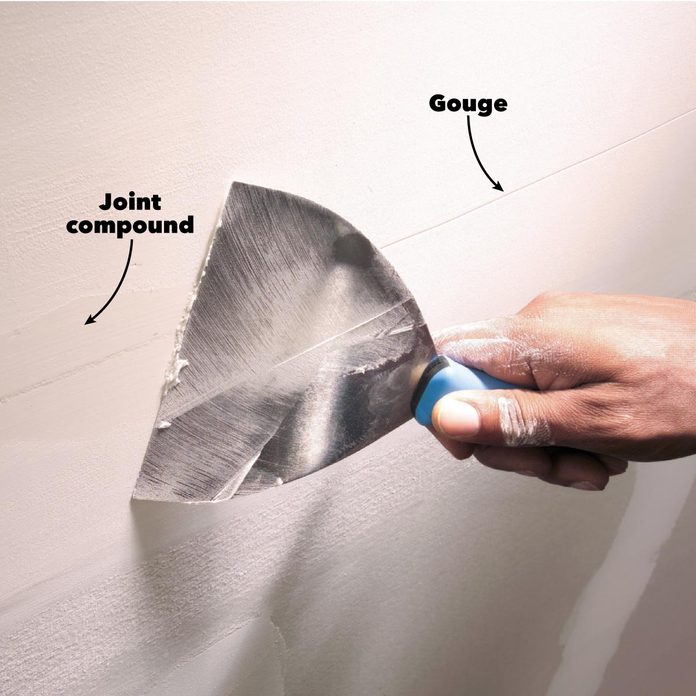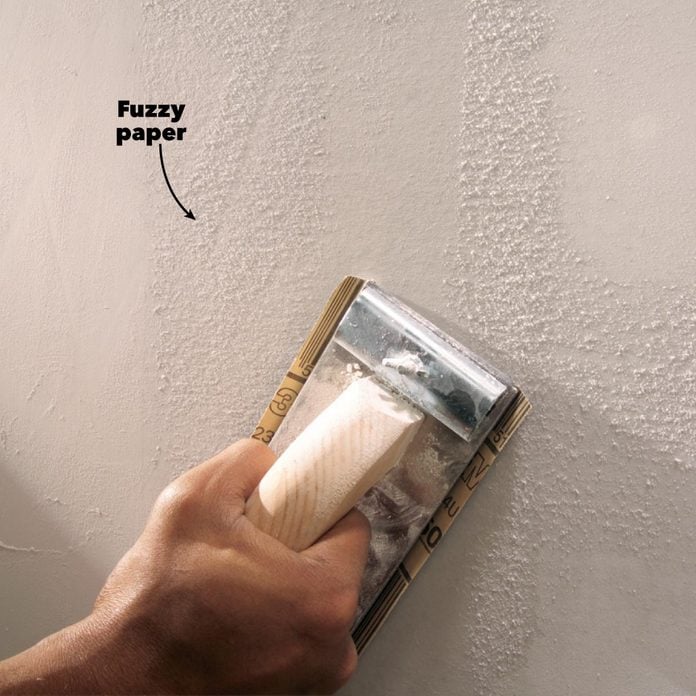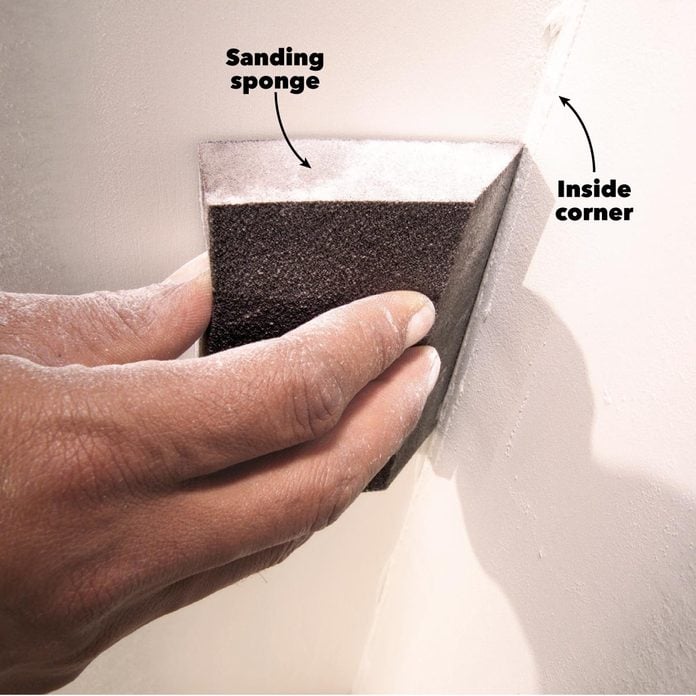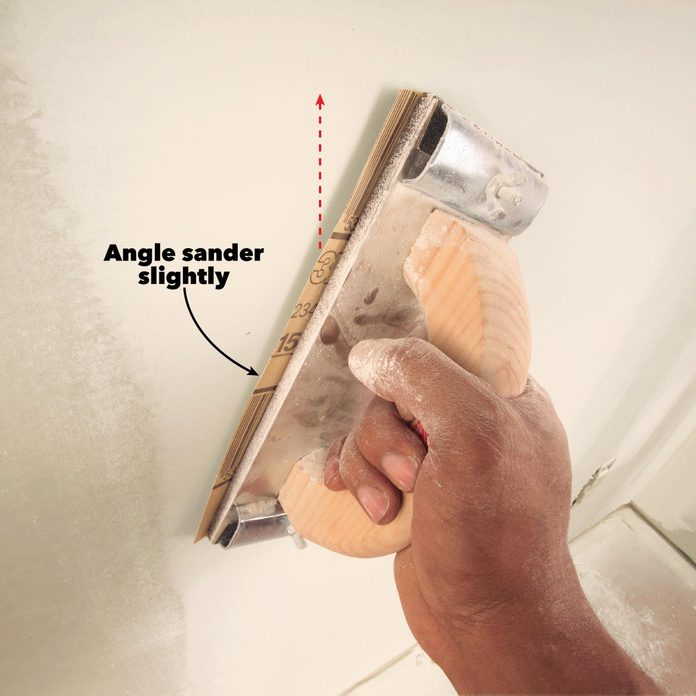How To Sand Paint Repair Drywall
Drywall Sanding Tips and Techniques
All the best tips and techniques for a smooth drywall surface.
![]() Time
Time
A full day
![]() Complexity
Complexity
Beginner
![]() Cost
Cost
$51–100
Introduction
In this commodity, we'll show you how to avoid common sanding mistakes and offer several tips for getting the best results from your drywall sanding job. Sanding drywall is tedious, dusty work. But if you practice it right, you'll be rewarded with a great-looking pigment job that will brand all the endeavour worthwhile.
Tools Required
Materials Required
- 150-grit sandpaper
- Joint compound
Projection pace-by-step (7)
Footstep 1
Utilize a special sanding tool
As with most remodeling tasks, having the correct tools is the key to a top-notch job. For drywall sanding, you'll need a manus sander, a bundle of 150-grit drywall sanding paper that's precut to fit your sander, and a sanding sponge for corners and detail sanding. You'll also need a double-strap dust mask rated for nuisance grit and goggles to go on the dust out of your eyes. A hat or scarf to proceed the grit out of your hair is a good thought too.
Pole sanders are good for big sanding jobs. Nosotros didn't show a drywall pole sander ($15) because it'southward tricky to learn. Just if you've got more than one room to sand, information technology may be worth the endeavour to pick upward a drywall pole sander. The trouble with a drywall pole sander is that if you're non careful, the sander can flip over and gouge the surface, causing extra repair work. Ane tip is to go on the sanding head angled slightly and never permit information technology get at a right angle to the pole. A drywall pole sander works cracking for sanding the drywall primer coat before painting, a stride that requires minimal control and pressure.
Using a drywall sander
Sand with light pressure level forth the edge of seams and around screws to avoid "fuzzing" the drywall paper. Sand the center of seams just enough to remove ridges and bumps.
Command the Dust
If you're not careful, drywall dust can migrate through the business firm, forming a white film on everything in its path. It'south difficult to go rid of, likewise. You may have heard nigh smoothing the joints with a damp sponge rather than sandpaper to avert the dust. But information technology's well-nigh impossible to go a top-notch job with this method. There are dust-catching sanding systems on the market, but they're expensive and tricky to acquire. The best selection is to suit up with protective gear.
Footstep 2
Cull fine sandpaper for the best results
It's tempting to buy eighty-dust paper to speed upwardly the sanding job. But because modern lightweight joint compound is so soft, you don't demand heavy-grit newspaper to sand it. Coarse-dust paper or sanding screens will leave undesirable sanding marks.
We recommend 120-dust or 150-grit paper for the best results. Buy precut sheets made to fit your manus sander. It also fits half sheets of standard size newspaper.

Employ fine dust sandpaper
Install 150-grit paper on your hand sander. Make sure information technology's taut by first anchoring 1 stop under the clamp. Then push the other finish nether the other clamp with one hand while you tighten the clamp screw with the other.
Step iii
Fill gouges, don't sand them
Don't try to sand out gouges and big ridges. It's much easier just to trowel on another coat of joint compound. This is especially important at the border of joints, where likewise much sanding will damage the paper face on the drywall.
Information technology'due south quick and easy to trowel a thin glaze over the edge of the seam to fill a depression. You don't accept to encompass the entire articulation once more.

Fill up grooves with more articulation compound
Affect upwards grooves and big ridges with another coat of joint chemical compound rather than trying to sand them out. It may accept a few coats to fill up deep grooves.
Step 4
Spot problem areas with a handheld light
Kickoff do a one time-over with your mitt sander, making certain to hitting every surface with joint chemical compound on it. Go along a pencil handy to marker problem areas that need filling or detail sanding. Next go a handheld lamp and go back over the chore while shining the calorie-free parallel to the wall surface.
Use your hand sander and sponge sander to touch up trouble spots. Mark depressions and other spots that need filling. Cease the chore past filling the marked areas with articulation chemical compound and finally sanding these spots when they dry.

Shine a light on the wall to spot problems
Go back over the walls and ceiling with a light and a sander. Circumvolve dings, pits, sanded-through areas and other problems with a pencil. Then go back and touch them upward with joint compound. Resand these spots when they dry.
Step 5
Prime number the walls, so sand once again
Sanding after priming is a critical pace that near beginners skip. But sanding before painting removes paper fuzz and lumps that volition prove through your paint job. This is also the time to take care of other imperfections by filling them with joint compound.
Don't forget to sand and reprime these touched-upwardly areas or they'll also evidence upwardly when you pigment the walls.

Sand the wall after priming
Prime the walls and sand them lightly after the primer dries to remove paper fuzz and lumps.
Step six
Use a sanding sponge for corners
Sanding within corners with a hand sander is asking for trouble. In the first place, it's difficult to get a crisp corner. But even more troublesome is the trend to scuff or gouge the contrary side of the corner with the edge of the sander. It'due south OK to sand within a few inches of the corner with your hand sander. And then go dorsum and touch up with a sanding sponge or folded piece of drywall sanding newspaper.

Sand corners with a sponge
Sand corners with a fine sanding sponge rather than the large hand sander.

Manus sanders can gouge corners
Oops! Got too close with a manus sander and gouged the corner. Touch on it upwards and try again, with a sponge this time.
Footstep vii
Sand with a light impact
Even though using a hand sander is straightforward, the drywall pro we talked to offered these helpful tips. Employ moderate to light pressure and avoid sanding over the same spot in a directly line. This can leave a groove or depression that will show up when you paint. Instead, motion the sander effectually on the joint as you sand. Don't sand over electrical boxes or other openings.
The edges of the box can rip your sandpaper, or a piece of the paper facing on the drywall can roll up nether the sander and tear off. Go on a few inches away from electrical box openings and bear upon up around them later with a sanding sponge.

Avert over-sanding
Oops! Sanded too much in this spot. Touch it upwardly with joint compound and resand when it dries.

Bending the sander and press lightly
Keep the sander angled slightly. Press lightly and avoid scrubbing dorsum and forth in one spot.
Originally Published: May 21, 2022
Source: https://www.familyhandyman.com/project/drywall-sanding-tips-and-techniques/
Posted by: mangualtoons1960.blogspot.com



0 Response to "How To Sand Paint Repair Drywall"
Post a Comment